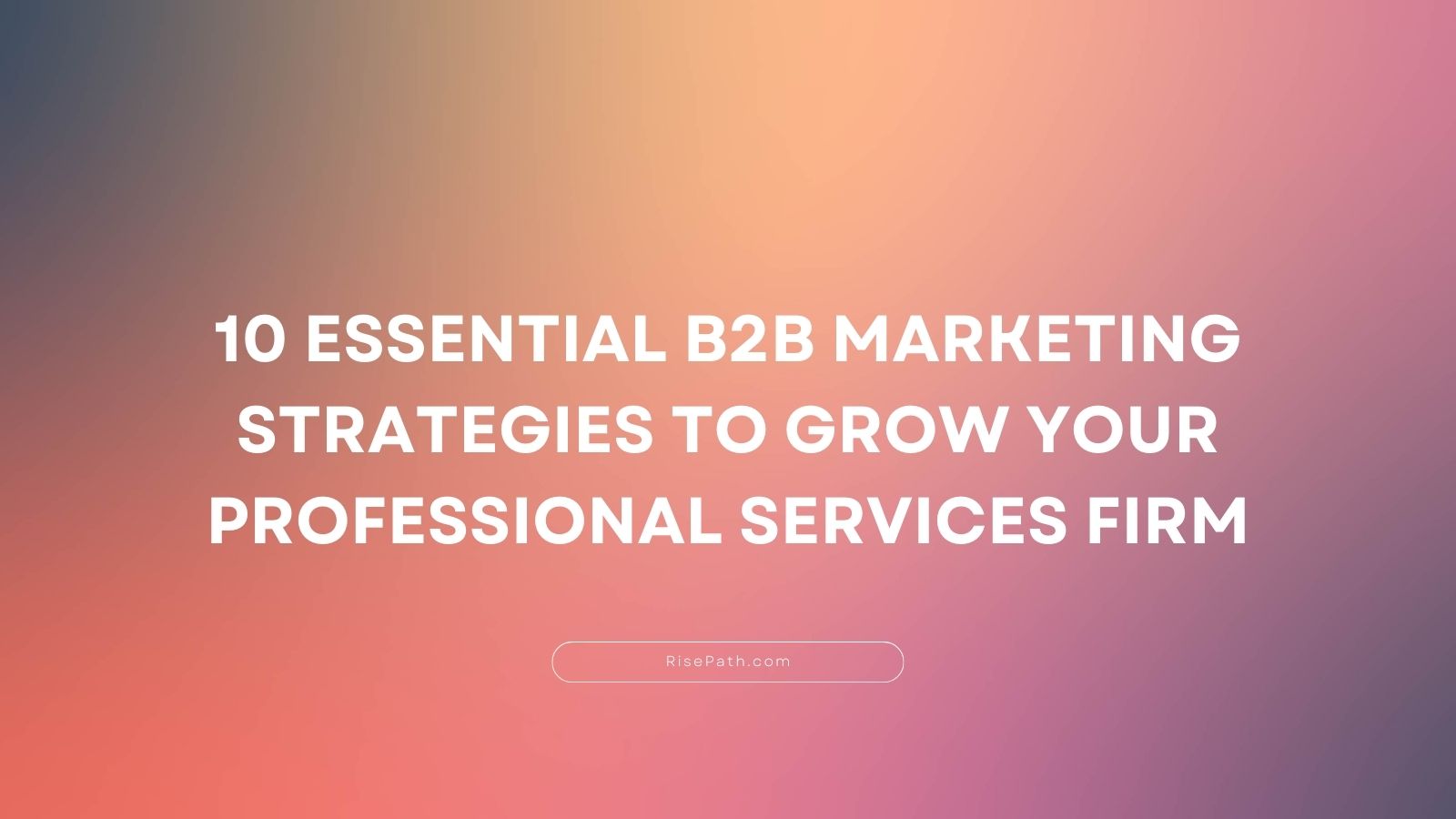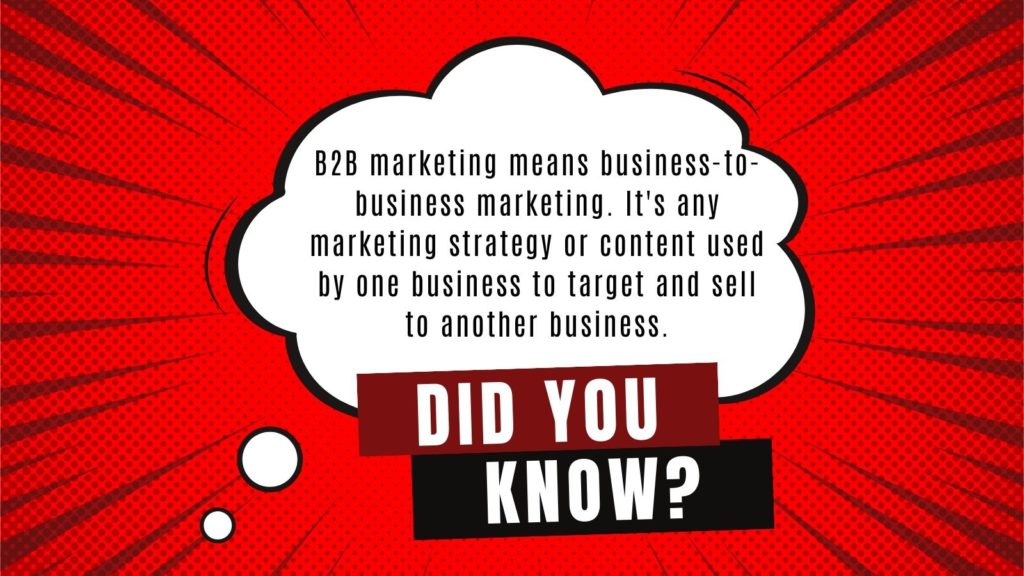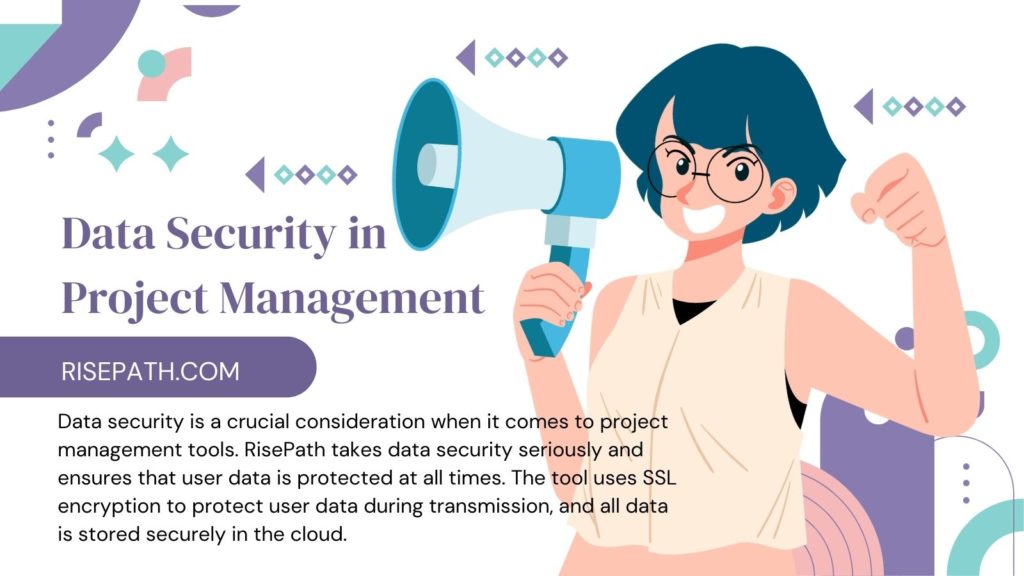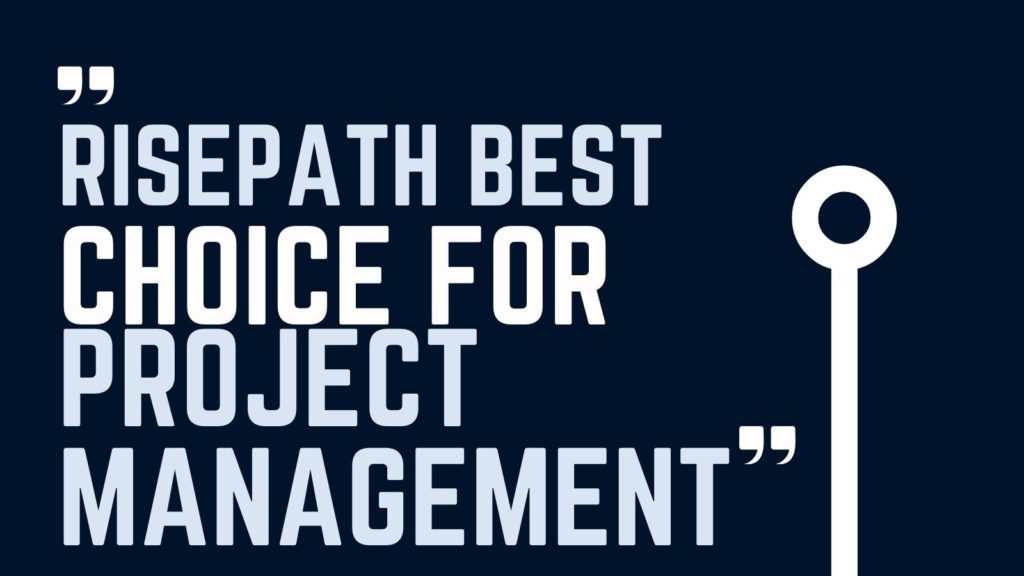In the ever-evolving world of B2B marketing, it is important to stay ahead of the curve and find innovative ways to reach your target audience. Utilizing advanced targeting tactics can help ensure that your content and campaigns are seen by the right people. Investing in quality content is also key, as this can be an effective way to engage B2B audiences if you focus on providing useful, informative content that will benefit your target audience.
Leveraging social media is also a great way to build relationships with your target audience, as well as optimize your website for better performanceIn the dynamic realm of B2B marketing, staying at the forefront of navigating the dynamic landscape of B2B marketing.
Committing to high-caliber content is a vital strategy; crafting compelling, informative materials that offer value to your B2B audience can significantly bolster engagement. Additionally, harnessing the power of social media platforms provides a prime opportunity to cultivate relationships with your audience, while optimizing your website enhances its functionality and online presence.ation is crucial for connecting with your target audience effectively.
Developing a robust email strategy is also key for reaching potential clients, and investing in paid advertising can be a great way to get your message out and increase your reach. Utilizing video content can also be beneficial in engaging your target audience and driving more traffic to your website. Finally, it is important to track the results of your campaigns to ensure that your efforts are yielding the desired results.
By implementing these innovative B2B marketing strategies, you can ensure that your business is staying ahead of the curve and reaching your target audience in an effective way.
What is B2B Marketing?
B2B marketing is an important practice in marketing products and services to other businesses and organizations. As B2B marketers, it is our job to build relationships with other businesses and help them find solutions to their problems. To do this, we must have a well-thought-out marketing strategy that is tailored to our target audience.
One of the most effective ways to reach our desired audiences is through the use of search engine optimization (SEO). By optimizing our content to ensure it appears on search engine results pages, we can ensure that our target audience will find us. Additionally, email campaigns, social media, and other digital marketing tactics can be used to reach a wider audience.
Innovation is key in the world of B2B marketing. We must stay up-to-date on the latest trends in digital marketing and use them to create more effective campaigns. Furthermore, leveraging data and technology to create personalized experiences for our target audiences can help us build relationships with them.
By utilizing innovative strategies and staying up to date on the latest trends, B2B marketers can create effective campaigns that will reach their target audiences and help them find solutions to their problems.
Also Read: Mastering Workflow Management Marketing Efficiency
In the ever-evolving landscape of innovative B2B marketing strategies, it’s essential to leverage cutting-edge tools and technologies that can elevate your brand’s visibility and credibility in a crowded marketplace. From harnessing the power of account-based marketing (ABM) to customize your approach for each key account, to integrating artificial intelligence and machine learning for predictive analytics and personalized content delivery, successful B2B marketers are constantly finding new ways to connect with their audience.
Furthermore, the rise of social media platforms like LinkedIn for professional networking has created unique opportunities for B2B marketers to engage with prospects through thought leadership content and targeted advertising.
To fully capitalize on these trends, it’s crucial to optimize your online presence for search engines—employing SEO best practices to ensure that your most valuable content is easily discoverable by those who are actively seeking the solutions that your business provides. A well-executed SEO strategy can dramatically increase the quantity and quality of leads, driving measurable results in your B2B marketing efforts.
B2B Marketing Examples
The business landscape is ever-evolving, and innovative B2B marketing strategies are essential to keeping up with the competition. Social media is a great way to build relationships with existing customers and reach new ones. Platforms such as Facebook, Twitter, and Instagram offer invaluable opportunities to engage with customers. Utilizing personalized email campaigns to target specific customer segments is another powerful way to reach out to potential customers. Online advertising can be used to generate leads and increase website traffic.
Hosting virtual events can be a great way to engage customers and create a sense of community. By developing content marketing campaigns that provide educational and helpful resources to customers, businesses can position themselves as thought leaders in their industry. Loyalty programs are also a great way to reward customers for their business. By leveraging data, businesses can create targeted campaigns with personalized messaging.
Referral programs are a great way to incentivize customers to spread the word about their products and services. Automation tools such as chatbots can also be used to streamline customer service and sales processes. By implementing some of these innovative B2B marketing strategies, businesses can stay ahead of the competition and see impressive results.
Certainly! Here are a few examples that you can integrate into your section regarding innovative B2B marketing strategies, particularly focusing on referral programs and automation tools.
B2b marketing Referral programs
1. Dropbox’s Referral Program:
Dropbox used a simple but powerful referral program to grow its user base. For every friend that a user referred, both the referrer and the friend received additional storage space. This incentive spurred rapid word-of-mouth marketing and was a game-changer in B2B contexts where businesses sought cloud storage solutions.
2. Salesforce’s Advocate Program:
Salesforce, the leading CRM platform, implemented a customer advocacy program that rewards users for activities such as referring new clients, participating in testimonials, or acting as brand ambassadors. By recognizing and harnessing the power of happy customers, Salesforce continues to see robust growth in its user base.
3. American Express’s Referral Program:
American Express offers existing cardholders the opportunity to refer friends and business partners to their services. For each successful referral that results in a new account, the referrer earns reward points that can be redeemed for various benefits, thus encouraging B2B client recommendations.
4. HubSpot’s Partner Program:
HubSpot created a partner program that encourages other businesses to refer clients to its marketing, sales, and service software. In return, partners receive benefits like increased revenue from reselling and co-marketing opportunities, making it a win-win for all parties involved.
B22 Automation Tool Examples
1. Chatbots for Customer Service:
Intercom and Drift provide AI-powered chatbots that can answer customer queries, assist with troubleshooting, or guide users through a sales funnel 24/7. By incorporating these into their websites, B2B companies improve customer experience and free up human customer service reps to deal with more complex issues.
2. Automated Email Campaigns:
Platforms like Mailchimp and Marketo offer solutions where B2B marketers can set up automated email workflows. These can trigger emails based on customer behavior, such as onboarding sequences once a demo is requested, nurturing leads, or re-engaging dormant customers.
Also Read: The Role of Email Marketing in Customer Retention
3. Social Media Management:
Tools like Hootsuite and Buffer allow businesses to automate their social media posting and engagement. B2B companies use these to schedule content, analyze performance, and manage all their social media accounts in one place, which leads to a more efficient marketing strategy.
4. AI-Powered Personalization Engines:
Artificial intelligence platforms like Adobe Sensei or Optimizely can personalize website content in real-time based on visitor behavior and data. This type of automation means B2B businesses can deliver more relevant experiences to potential clients, often resulting in higher conversion rates.
Top 10 B2B Marketing Strategies
mplement retargeting strategies to stay top-of-mind with potential customers.
In today’s competitive B2B marketing landscape, it’s essential to stay ahead of the game. To do this, it’s important to have an innovative marketing strategy that will set you apart from the competition. Here are some of the best B2B marketing strategies to help you stay ahead of the pack.
The first step in creating an innovative B2B marketing strategy is to research the market and identify customer needs and wants. Additionally, it’s important to research the competition to ensure that you’re staying ahead of them. To increase your reach, take advantage of networking platforms like LinkedIn and Facebook to find potential customers.
Establishing a strong online presence is also key to staying ahead of the competition. Develop a strong presence on relevant social media platforms and use SEO tactics to increase website visibility. It’s also important to create content that is tailored to each customer segment and provides value.
You can also leverage influencers to spread the word about your company and products. Additionally, you can automate processes and tasks to save time and resources. Investing in advertising, including search engine ads and display ads, can also help to increase brand visibility.
1. Research
Building relationships with customers is a great way to stand out from the competition and provide an excellent customer experience. Content marketing is another way to reach out to potential customers and provide valuable information. Utilizing social media platforms such as Facebook, Twitter, and Instagram to promote your brand and services is also essential in the modern marketing landscape. Influencer marketing is a powerful way to get your message out to the right people by partnering with industry influencers to create content that will reach your target audience. Lastly, email is still one of the best ways to reach customers, so create newsletters, special offers, and other content to stay in contact.
These innovative B2B marketing strategies can be used to create a powerful marketing presence for your business. Building relationships with customers, utilizing content marketing, leveraging social media, advertising through influencers, and utilizing email marketing can help you reach your target audience and make your business stand out from the competition. With the right strategies in place, you can create a powerful marketing presence that will help you reach your goals.
2. Niche-driven Strategy
Niche-driven marketing is an innovative strategy for businesses to reach a targeted, specific customer base. It is a great way to create a sense of loyalty among customers, differentiate a brand from its competitors, and test out new products or services. To effectively use a niche-driven strategy, it is important to first identify the target market. Businesses should take the time to understand the needs of their target market and create campaigns and content that are tailored to their interests and preferences.
By focusing on a small but dedicated customer base, businesses can create a personalized experience for their customers and build relationships with them. This can help create a strong customer base that will remain loyal to the brand and buy its products or services. A niche-driven strategy is also a great way to test out new products or services before launching them to a wider audience. This can help businesses refine their products and services before launching them to a wider market.
Innovative b2b marketing strategies, such as niche-driven strategies, are a great way to reach a targeted customer base. By taking the time to understand the needs of the target market and creating tailored campaigns and content, businesses can create a personalized experience for their customers and build relationships with them. This can help create a strong customer base that will remain loyal to
3. A High Performance Website
In today’s competitive business environment, B2B companies need to stay ahead of the curve when it comes to innovative marketing strategies. One effective strategy is to invest in a high-performance website that can help to engage potential customers and track their data. By leveraging the website, companies can create content that is engaging and helps to promote their products and services. This content can also be used to boost SEO rankings and improve customer experience.
Having an effective website that is optimized for customer engagement is a great way for B2B companies to position themselves as leaders in their industry. By tracking and analyzing customer data, companies can gain valuable insights into their target market and create campaigns that are tailored to their customers’ needs. This will not only help to drive more traffic to the website, but it can also help to increase customer retention rates.
To maximize the effectiveness of a high-performance website, B2B companies should focus on creating content that is relevant to their target audience. This content should be engaging and provide valuable information that will help to increase customer engagement and loyalty. Additionally, companies should also ensure that their website is optimized for search engine rankings and user experience. By taking these steps, B2B companies can ensure that their website is an effective tool for marketing and staying ahead of
4. Search Engine Optimization (SEO)
In the b2b marketing world, staying ahead of the competition is key. To ensure you are delivering the most innovative marketing strategies to your clients, staying up to date on the latest trends is essential. Here are some of the most effective innovative b2b marketing strategies that you should consider:
Creating optimized content with keywords is one of the most important b2b marketing strategies. This ensures that you are targeting the right audience and increasing website visibility. Having an effective link-building strategy is also key to earning backlinks from trusted websites. Utilizing tools such as Google Analytics can also help you track and measure SEO performance.
Another effective b2b marketing strategy is focusing on improving website speed and mobile usability. This is essential to increase organic rankings and provide a better user experience. Incorporating structured data can also help optimize content for voice search. Additionally, implementing local SEO strategies can help you target local customers. Last but not least, optimizing images and other media can also help improve search engine rankings.
By incorporating these innovative b2b marketing strategies, you can ensure that you are staying ahead of the competition and delivering the best results to your clients.
6. Advertising
In the modern business world, the need to develop innovative b2b marketing strategies has never been greater. With the rise of digital marketing, companies are presented with a variety of opportunities to reach their target audience. Here are some innovative B2B marketing strategies to consider:
Leverage Social Media Platforms: Social media platforms such as Facebook, Instagram, and Twitter are great tools for promoting products and services. They allow businesses to reach a larger audience and engage with potential customers. Develop a unique content strategy to ensure that the content you produce is tailored to your target audience and provides value.
Utilize Video Content: Video content can be an effective way to communicate your message and engage with your audience. It can be used to showcase your products and services, explain complex topics, or demonstrate how your product works. Videos can be used to build trust and create positive brand awareness.
Incorporate Influencer Marketing: Partnering with influencers can be a great way to reach a larger audience and increase brand awareness. Influencers can help to promote your products and services in a positive light and generate more leads.
Optimize Your Website: Optimizing your website is a foundational aspect of any innovative B2B marketing strategy because it serves as the central hub for your online presence. When your potential business clients look for the services or products you offer, a well-optimized website helps ensure that they find you.
Below, I will elaborate on the critical aspects of website optimization, with a focus on SEO (Search Engine Optimization) and mobile-friendliness.
To optimize your website for SEO, you should consider the following strategies:
1. Keyword Research: Identify the keywords that potential B2B clients use when searching for products or services in your industry. Tools like Google Keyword Planner can help you with this task.
2. On-Page SEO: Optimize your website’s content and structure by including targeted keywords in your titles, headings, meta descriptions, and throughout your website’s content. Ensure that each page is focused on a specific topic or keyword.
3. Quality Content: Create informative and valuable content that addresses the needs and questions of your target audience. High-quality content is likely to be shared and referenced, increasing the authority of your website.
4. Site Structure: Structure your website with a clear hierarchy and use internal linking to help search engines understand the relationship between different pages on your site.
5. Technical SEO:Improve website loading speed, ensure all pages are indexed correctly by search engines, implement structured data (schema markup), and make sure your site is secure with HTTPS.
6. Backlinks: Build a strong backlink profile by getting reputable websites to link back to your content. This improves your site’s credibility and authority in search engine algorithms.
Mobile-friendliness
As more professionals use mobile devices to research B2B vendors, ensuring your website is mobile-friendly is crucial.
1. Responsive Design: Employ a responsive web design that automatically adjusts content layouts to fit the screen size of various devices.
2. Load Time: Optimize images and use modern coding techniques to ensure your website loads quickly on mobile networks.
3. Navigation: Ensure that your site navigation is easy to use on smartphones and tablets. Large, easy-to-click buttons and a simplified menu can improve the user experience on mobile.
4. Touchscreen Ready: Design elements like buttons and form fields should be large enough to touch and spaced accordingly to prevent accidental clicks.
5. Mobile-First Indexing: Because Google predominantly uses the mobile version of the content for indexing and ranking, it’s vital to ensure that your mobile site contains the same high-quality content as your desktop version.
In summary, optimizing your website for SEO and mobile responsiveness increases your visibility in search engine results, which is especially important in the B2B market, where purchase decisions are often researched thoroughly online. By ensuring your website adheres to best practices in SEO and mobile design, you’ll be better positioned to attract and engage with potential business clients.
7. Referral Marketing
Referral marketing is an effective and cost-efficient way for businesses to reach new customers and increase sales. By leveraging customer networks and reaching out to potential customers, businesses can build relationships with current customers and generate word-of-mouth buzz. Referral marketing can also help businesses generate more qualified leads and build trust with their customers. Businesses can reward their existing customers with incentives such as discounts and free products in exchange for referrals, which can help increase customer loyalty. With the right strategy, businesses can get the most out of referral marketing and maximize their marketing efforts.
It is important to have a well-thought-out plan for referral marketing. Businesses should create an incentive program that rewards customers for referring new customers to the business. This could be a discount or free product. It is also important to make sure that current customers know about the referral program. Businesses can use email, social media, or even print materials to get the word out.
Referral marketing is a powerful and cost-effective marketing strategy where businesses encourage their existing customers to recommend their products or services to friends, family, and colleagues. This form of marketing leverages the trust and personal relationships that customers have within their networks to gain new leads and ultimately convert them into customers. Here’s how businesses can optimize their referral marketing strategies in the context of B2B marketing:
1. Leveraging Customer Networks:
In a B2B context, leveraging customer networks can be particularly effective since business relationships often rely on trust and proven results. B2B buyers are more likely to consider a product or service that has been endorsed by their peers or partners. Companies can identify key customers who are satisfied with their products and services and are likely to make referrals.
2. Strategies for Encouraging Referrals:
Unlike B2C, where the decision-making process might be more impulsive, B2B purchasing decisions are often made collectively and require more thought and consideration. When implementing referral strategies in B2B marketing, it’s important to provide clear, tangible benefits that align with professional needs. This could involve offering discounts on future services, upgrades, or exclusive access to new products or services.
Also Read: Unveiling the Power and Relevance of Email Marketing in 2023
3. Rewarding Customers with Incentives:
Incentives play a pivotal role in referral marketing. For B2B businesses, the incentives should be tailored to the audience. Common rewards include discounts on services, cashback, extended free trials, or enhanced support. For more strategic partnerships, the rewards might include joint marketing efforts or revenue-sharing arrangements. The incentives should be compelling enough to prompt action without overshadowing the value of the products or services offered. 4. **Promoting the Referral Program:**
To get the word out about the referral program, B2B marketers should employ multiple tactics, including email marketing, social media, webinars, and industry events. By promoting the program through channels frequented by their customer base, companies can maximize visibility and uptake of the referral offer.
5. Tracking and Analysis:
To truly maximize the results of a referral marketing strategy, businesses must track the performance of their referral programs. This includes monitoring metrics such as the number of referrals, conversion rates, and the average value of referred sales. By analyzing this data, B2B marketers can understand which parts of their program are working and which may need adjustment.
6. Personalization and Segmentation:
Sending out a blanket referral request to all customers isn’t always effective. Segmenting customers based on factors such as industry, company size, or previous purchasing behavior can help in tailoring the message and offer to be more relevant and appealing, thus increasing the chances of referrals.
7. Maintaining Relationships:
After a referral is made, it’s essential to maintain the relationship with both the existing customer and the new referral.
8. Marketing Automation, CRM, and Lead Nurturing
B2B companies need to find innovative ways to engage potential customers, nurture leads, and drive more conversions. Here are some of the most effective and innovative B2B marketing strategies:
Marketing Automation: Automating marketing activities such as email campaigns, social media posting, and other repetitive tasks can help save time and resources. This allows businesses to scale their marketing efforts and focus on more strategic initiatives.
CRM: Keeping track of customer data, customer segmentation, and customer profiles can help businesses better target potential customers and retain existing customers. This also allows businesses to personalize their marketing messages for each customer.
Lead Nurturing: Utilizing marketing automation and CRM can help businesses continuously engage with and provide content to potential customers to move them further down the sales funnel. This ensures that potential leads are continuously nurtured and get the right content at the right time.
Personalization: By leveraging customer data, businesses can customize content and messaging for specific customers. This could include sending tailored emails to customers based on their location, interests, or past purchases. Personalization can help create more meaningful relationships with customers and improve customer loyalty.
9. Testing and Optimization
Testing and optimization are essential components of any successful b2b marketing strategy. Testing allows marketers to measure the effectiveness of different strategies and tactics, so they can make informed decisions about which ones to pursue. By making small changes to a strategy or tactic, marketers can optimize their efforts and maximize the effectiveness of their b2b campaigns. Automated testing and optimization tools can help marketers quickly identify areas of improvement and maximize their ROI.
Testing and optimization can help marketers stay ahead of the competition by continually improving their b2b marketing strategies. Through testing and optimization, marketers can identify new opportunities for growth and expansion, as well as increase the effectiveness of their B2B. By testing and optimizing their strategies, marketers can ensure that their b2b campaigns are reaching their target audience and producing the desired results.
Testing and optimization are essential tools for any B2B marketer looking to maximize their ROI and remain competitive in an ever-evolving market. Through testing and optimization, marketers can identify the strategies and tactics that will produce the best results for their business. With the help of automated testing and optimization tools, marketers can quickly and easily identify areas of improvement and adjust their strategies accordingly. Testing and optimization can help marketers stay ahead of the competition and ensure that their B2B campaigns are successful.
10. Analytics and Reporting
Analytics and Reporting is an essential tool for B2B businesses to maximize their marketing strategies and craft effective approaches. With Analytics and Reporting, B2B businesses can gain valuable insights into customer behavior and identify areas of potential growth. By tracking customer engagement with products and services, businesses can evaluate and optimize their marketing campaigns for maximum ROI.
Integrating Analytics and Reporting into all aspects of B2B marketing strategies gives businesses a comprehensive view of their target audience and allows them to develop targeted campaigns based on customer preferences and behaviors. Leveraging Analytics and Reporting also enables businesses to analyze trends in B2B marketing and adjust their strategies accordingly.
To ensure maximum success, businesses should also monitor their customer base for changes in buying behavior. Utilizing Analytics and Reporting to track customer journeys from initial contact to final purchase is also a great way to stay ahead of the competition and develop creative B2B marketing solutions. With the right use of Analytics and Reporting, B2B businesses can gain a competitive edge and significantly improve their marketing performance.
B2B vs B2C Marketing
In today’s competitive business world, businesses of all sizes are looking for innovative ways to market their products and services. While B2C marketing tactics are typically more well-known, B2B marketing is just as important – especially when it comes to developing relationships with other businesses.
B2B marketing focuses on building relationships with other businesses, while B2C marketing focuses on building relationships with individual consumers. B2B marketing strategies tend to be more complex and focused on a smaller target audience, while B2C strategies are typically less complex and focus on a larger target audience. B2B marketing often involves longer sales cycles, while B2C marketing typically involves shorter sales cycles. B2B marketing is often more focused on business-specific metrics such as return on investment, while B2C marketing is more focused on customer-centric metrics such as customer satisfaction.
Also Read: Innovative B2B Marketing Strategies to Stay Ahead of the Competition
For B2B marketers to stay ahead of the competition, they need to find innovative ways to reach their target audience. B2B marketing typically relies on more traditional marketing tactics such as print, trade shows, and direct mail, while B2C marketing often incorporates more innovative tactics such as social media, content marketing, and influencer marketing.
A Final Thought
No matter the size of your business, B2B marketers can benefit from the “final thought” strategy. This strategy encourages innovation and creativity, allowing marketers to stand out from their competitors. It is an effective way to create a unique and memorable experience for customers. It allows B2B marketers to think outside the box and come up with creative ideas to differentiate themselves from other companies.
The “final thought” strategy also helps B2B marketers to make a lasting impression on customers. By providing them with valuable insights and information, customers are more likely to remember your company. It also helps to create a strong and positive brand image. This strategy can be used to establish trust and credibility with customers, as it shows that you are willing to go the extra mile to provide them with the best experience possible.
For B2B marketers, the “final thought” strategy is a powerful tool for creating a memorable customer experience. It allows them to stand out from their competitors and create a strong and positive brand image. By implementing this strategy, B2B marketers can make a lasting impression on customers and establish trust and credibility.





Comments are closed, but trackbacks and pingbacks are open.